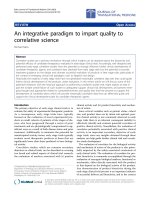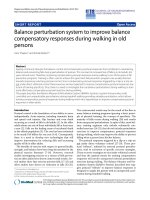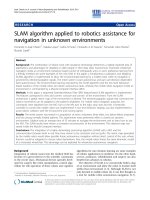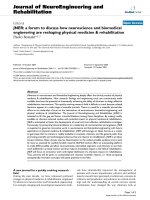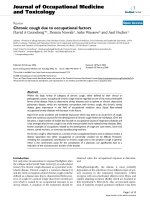báo cáo hóa học: " Ting JY: Letter to the Editors: The potential role of prehospital thrombolysis and time-critical stroke transfers in the northern Norway aeromedical retrieval system." potx
Bạn đang xem bản rút gọn của tài liệu. Xem và tải ngay bản đầy đủ của tài liệu tại đây (98.26 KB, 1 trang )
LE T T E R TO THE EDITORS Open Access
Ting JY: Letter to the Editors: The potential role
of prehospital thrombolysis and time-critical
stroke transfers in the northern Norway
aeromedical retrieval system.
Jan Norum
1,2,3
In our study [1], we reported a lengthy 3 h 33 min one-
way transfer time from the Norwegian Arctic to the main-
land. However, I fully agree with Ting that we should have
focused more on the present system where ECGs may be
communicated digitally from the ambulances, district
medical centers and local hospitals to cardiologists at the
main hospitals. This was however mentioned in our pre-
vious article on ambulances [2]. In practice, patients in the
Svalbard Islands are now transported to the small hospital
unit in Longyearbyen for diagnosis (ECG) and initial treat-
ment. The ECG is then communicated digitally to the car-
diologistondutyattheUniversityHospitalofNorth
Norway (UNN) located on the mainland (city of Tromsø).
The recognition of STEMI can be achieved and advice
concerning prehospital thrombolysis given by the cardiolo-
gist prior to the lengthy transfer to the mainland. In some
settings ECGs may also be communicated from minor
bases in the Arctic, but be aware of communication pro-
blems this far to the north [3]. I am aware of one case
where an ECG was sent by fax from a remotely located
base (Jan Mayen) in the Norwegian Arctic to the UNN.
Concerning neurological/stroke patients, there is at pre-
sent intense debate about whether the small hospital unit
at Longyearbyen on the Svalbard Islands should be
equipped with a CT scanner. Such a tool would make
diagnosis of patients suitable for thrombolysis possible.
However, such an investment will not b e cost-effective
with a low volume of patients and must be considered
only from a preparedness point of view. I agree with Ting
that it is uncertain whether more Arctic tourism will
increase the aeromedical workload. However, the
increasing activity with re gard to oil and gas installations
together with shipping should also be considered in this
setting [3].
Author details
1
Northern Norway Regional Health Authority trust, N-8038 Bodø, Norway
2
Department of Clinical Medicine, Faculty of Health Sciences, University of
Tromsø, N-9037 Tromsø, Norway
3
Department of Oncology, University
Hospital of North Norway, N-9038 Tromsø, Norway
Competing interests
The author declares that they have no competing interests.
Received: 23 June 2011 Accepted: 18 July 2011 Published: 18 July 2011
References
1. Norum J, Elsbak TM: Air ambulance services in the Arctic: a Nowegian
study. Int J Emerg Med 2010, 3:69-74.
2. Norum J, Elsbak TM: The ambulance services in northern Norway 2004-
2008: improved competence, more tasks, better logistics and increased
costs. Int J Emerg Med 2011, 4:1 [ />3. Norum J: Cardiovascualr disease (CVD) in the Norwegian Arctic. Air
ambulance operations 1999-2009 and future challenges in the regions.
Int Marit Health 2010, 62:117-22.
doi:10.1186/1865-1380-4-43
Cite this article as: Norum: Ting JY: Letter to the Editors: The potential
role of prehospital thrombolysis and time-critical stroke transfers in the
northern Norway aeromedical retrieval system International Journal of
Emergency Medicine 2011 4:43.
Correspondence:
1
Northern Norway Regional Health Authority trust, N-8038 Bodø, Norway
Full list of author information is available at the end of the article
Norum International Journal of Emergency Medicine 2011, 4:43
/>© 2011 Norum; l icensee Springer. This is an Open Access article distributed under the t erms of the Creative Commons Attribution
License ( ), which permits unrestricted use, distribution, and reproduction in any medium,
provided the original work is properly cited.

